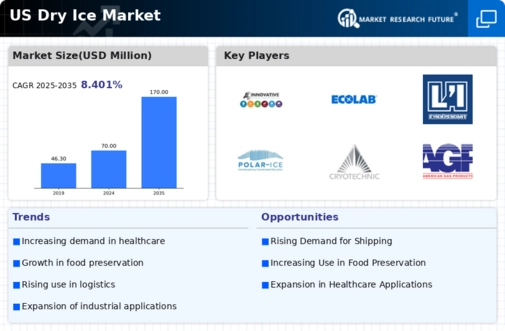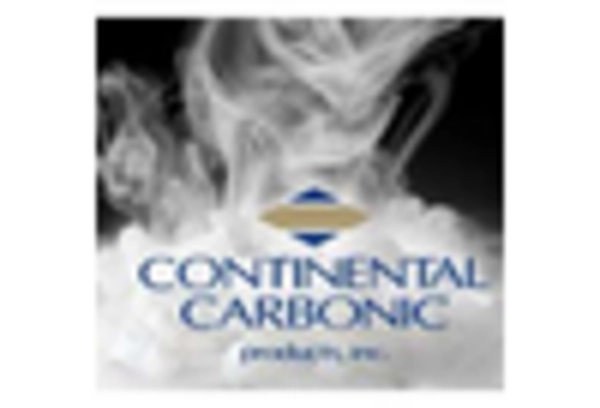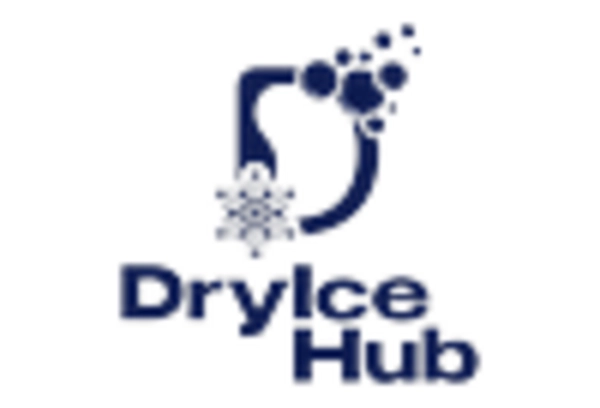Expansion of the Healthcare Sector
The expansion of the healthcare sector significantly impacts the dry ice market. With the increasing need for effective storage and transportation of vaccines, biological samples, and other temperature-sensitive medical products, the demand for dry ice is on the rise. In 2025, the healthcare sector is expected to represent approximately 20% of the total dry ice consumption in the US. This growth is driven by the need for reliable cold chain logistics, which ensures that medical products remain within specified temperature ranges. As healthcare providers and pharmaceutical companies continue to prioritize the safe handling of sensitive materials, the dry ice market is likely to see sustained growth in this segment.
Technological Innovations in Dry Ice Production
Technological innovations in dry ice production are playing a crucial role in shaping the dry ice market. Advances in production techniques have led to increased efficiency and reduced costs, making dry ice more accessible to various sectors. In 2025, it is anticipated that improvements in production technology could lower the average cost of dry ice by up to 15%, thereby expanding its application across industries. Enhanced production methods not only improve the quality of dry ice but also contribute to meeting the growing demand from sectors such as food and beverage, pharmaceuticals, and logistics. This trend indicates a positive outlook for the dry ice market as it adapts to evolving market needs.
Growth in E-commerce and Online Grocery Delivery
The growth in e-commerce and online grocery delivery services is significantly influencing the dry ice market. As consumers increasingly turn to online platforms for their grocery needs, the demand for effective preservation methods during delivery has surged. In 2025, it is estimated that the online grocery sector will account for approximately 15% of the total dry ice consumption in the US. Dry ice is particularly favored for its ability to maintain low temperatures, ensuring that perishable goods remain fresh during transit. This trend not only highlights the changing consumer behavior but also underscores the importance of dry ice in facilitating efficient and reliable delivery services, thereby driving growth in the dry ice market.
Increasing Adoption in Logistics and Transportation
The dry ice market is experiencing a notable increase in adoption within the logistics and transportation sectors. This trend is primarily driven by the need for effective temperature control during the shipping of temperature-sensitive goods. As e-commerce continues to expand, the demand for reliable shipping solutions has surged. In 2025, the logistics sector is projected to account for approximately 30% of the total dry ice consumption in the US. Companies are increasingly utilizing dry ice to maintain the integrity of perishable items, pharmaceuticals, and other sensitive products during transit. This shift towards dry ice reflects a broader trend of prioritizing quality and safety in supply chains, thereby enhancing the overall growth potential of the dry ice market.
Rising Environmental Concerns and Sustainability Initiatives
The dry ice market is also influenced by rising environmental concerns and sustainability initiatives. As businesses strive to reduce their carbon footprint, dry ice emerges as a more environmentally friendly alternative to traditional refrigerants. Unlike many chemical refrigerants, dry ice sublimates into carbon dioxide, which is less harmful to the environment. In 2025, it is estimated that around 25% of companies in the food and beverage sector are actively seeking sustainable packaging solutions, including the use of dry ice. This shift not only aligns with consumer preferences for eco-friendly products but also positions the dry ice market as a key player in the transition towards greener practices.

















Leave a Comment